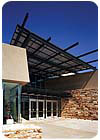
A recent 45,000-square-foot expansion to the Albuquerque Museum of Art and History in New Mexico included the extensive use of native travertine in a “dry stack†application.
Through permanent displays and special exhibitions, the Albuquerque Museum of Art and History features art of the Southwest and 400 years of the city's history. A recent 45,000-square-foot expansion to the museum, which was originally designed by noted architect Antoine Predock, in 1979, included the extensive use of native travertine for both exterior and interior features, as well as Turkish travertine for flooring throughout the space.
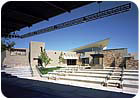
The museum's expansion - which included an 8,000-square-foot changing exhibitions gallery, a grand hall and entrance, special events hall, an expanded sculpture garden, new gallery store and a cafe - doubled the size of the original structure.
Furthermore, Rohde said that the client wanted “a dramatic and provocative design statement that would be an inviting attraction and establish a fresh signature for Albuquerque's 30-year-old institution.â€
To meet this desired aesthetic, architect's selected New Mexico travertine - which is quarried in Belin, NM, by Rocky Mountain Stone - in a “dry stack†application for the exterior facade of the building as well as interior walls. “New Mexico travertine was used because of its rich color, pattern and texture,†said Rohde. “It is truly an indigenous, local material that helps anchor the architecture to this region. The dry stack design has been done a lot in sandstone, and we were interested in using this particular stone in a dry stack application, which we hadn't seen before.â€

According to architect Mark Rohde from Rohde May Keller McNamara Architecture, the client wanted “a dramatic and provocative design statement that would be an inviting attraction and establish a fresh signature for Albuquerque's 30-year-old institution.â€
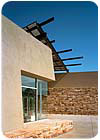
New Mexico travertine from Rocky Mountain Stone was selected for its rich color, pattern and texture, according to the architect.
The museum's expansion - which included an 8,000-square-foot changing exhibitions gallery, a grand hall and entrance, special events hall, an expanded sculpture garden, new gallery store and a cafe - doubled the size of the original structure.
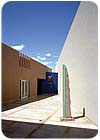
Turkish travertine from Milestone, Inc. of Santa Fe, NM, was added as flooring throughout the museum.
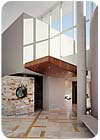
The flooring throughout the main lobby features 24- x 24-inch pieces of honed Turkish travertine with randomly placed, contrasting-colored dolomitic limestone insets in what Rohde refers to as a “Mondrianâ€-inspired pattern.
Albuquerque, NM
Architect: Rohde May Keller McNamara Architecture, Albuquerque, NM
General Contractor: Bradbury Stamm Construction, Albuquerque, NM
Subcontractor: Rockscapes, Albuquerque, NM; Kolle Tile, Inc., Albuquerque, NM (floor)
Stone Supplier/Quarrier: Rocky Mountain Stone, Albuquerque, NM (New Mexico travertine)
Stone Supplier: Milestone, Inc., Santa Fe, NM (Turkish travertine)